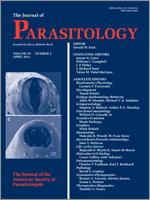A new species of dicyemid mesozoan is described from Octopus hubbsorum Berry, 1953, collected in the south of Bahia de La Paz, Baja California Sur, México. Dicyema guaycurense n. sp. is a medium-size species that reaches about 1,600 µm in length. It occurs in folds of the renal appendages. The vermiform stages are characterized as having 22 peripheral cells, a conical calotte, and an axial cell that extends to the base of the propolar cells. Infusoriform embryos consist of 39 cells; 1 nucleus is present in each urn cell and the refringent bodies are solid. This is the first of a dicyemid species from a host collected in the Gulf of California.
How to translate text using browser tools
1 April 2011
A New Dicyemid from Octopus hubbsorum (Mollusca: Cephalopoda: Octopoda)
Sheila Castellanos-Martinez,
M. Carmen Gómez,
F. G. Hochberg,
Camino Gestal,
Hidetaka Furuya
ACCESS THE FULL ARTICLE

Journal of Parasitology
Vol. 97 • No. 2
April 2011
Vol. 97 • No. 2
April 2011




